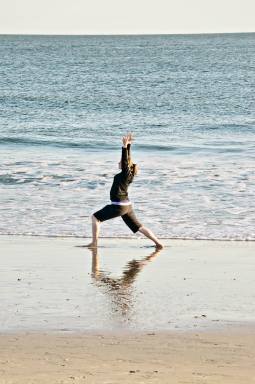Last week I went to a Wednesday night asana lab at YogaLife Institute. I’d never been there before, but I was excited about the topic of the seminar: moon salutations.
YogaLife is a little far from me – out in Devon, it’s about a 40-minute drive, plus a little extra on the way there with traffic. They have a nice large space with an area for shoes, a waiting room and shop, and it looked like several studio spaces, plus offices and a kitchen. In addition to being a yoga studio, they also produce Yoga Living magazine, so the office space makes sense, but it’s definitely a larger operation than most of the studios where I’ve practiced or worked!
I was really interested to attend the seminar on moon salutations, since I know very little about them. The seminar was really interesting – Kristen had us move back and forth through short portions of the sequence, from one pose to the next then back again, to help build some muscle memory and help us remember the sequence. We also did some simple stretches to help us gain awareness of the pelvis that we could then bring to the sequence, and did some group work too. Overall, it was the sort of class where I left my notebook on the floor while we practiced, then picked it up immediately afterward and scrawled frantically to try to get down everything I remembered. I found it really informative and fun, and the Wednesday night timeslot actually fit into my schedule! I’m looking forward to coming back here again!
The way Kristen taught the moon salutation was very different from the sun salutation many of us are so familiar with. Moon salutations are much more about movement: less about hitting the right pose in the right way and more about transitioning from pose to pose with awareness. Where sun salutes rely a great deal on upper body strength, moon salutations work the lower body, especially the pelvis. The group activities we did were intended to highlight the fact that, once we each got used to the sequence, each person did it a little bit differently: one woman’s transitions revealed the flexibility in her hips, while another’s movements left room to spare discomfort in her troublesome knees, and still another person moved very rhythmically, with small adjustments in each pose that set him up to flow seamlessly to the next. There’s no one way, and no wrong way, to do a moon salutation. I really liked the emphasis on fluidity and the uniqueness and beauty of each individual’s practice.
Here’s a graphic showing the sequence of poses. I don’t think it would help for me to list the asanas in order, because it’s less a list of postures to do in order and more like a dance, which I think the graphic emphasizes. If you try it at home you might make your version a little different. The squatting transition from one side to the other is particularly an area where the sequence will vary depending on the body of the practitioner; I also found a spot where I naturally wanted to insert half-moon pose (ardha chandrasana). I found this was a fun sequence to play with, and a perfect addition to my short 5:30 am yoga sessions. I hope you enjoy it too!







